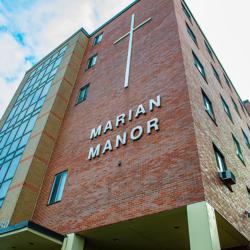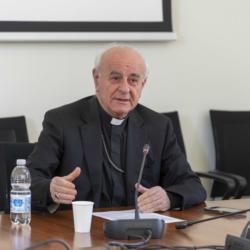Sisters of Notre Dame de Namur in New England -- The early years
In 1847, Father John McElroy, a Jesuit priest, on his way to serve as chaplain for soldiers during the Mexican-American War, stopped in Cincinnati to rest. While there, he celebrated Mass for the Sisters of Notre Dame de Namur and visited their convent schools. When he was sent to Boston the following year to find a house for the Jesuits, he remembered the sisters' work in Cincinnati. He wrote to Bishop John Purcell of Cincinnati to ask for any available Sisters of Notre Dame to take over the school at St. Mary Parish in the North End of Boston.
Despite the invitation, Boston did not welcome the three Sisters of Notre Dame warmly when they arrived. Sister Louis de Gonzague, Sister Magdalen, and Sister Mary Stanislaus stepped off the train after sunset on Saturday, Nov. 10, 1849, no doubt exhausted by their trek from Cincinnati. Though the American railway system in 1849 was extensive, the route between Ohio and Massachusetts required multiple stops and transfers. As was common then, the sisters wore lay dresses rather than their habits for travel. Aware of the anti-Catholic sentiments widely prevalent in the U.S., the sisters had good cause for wishing to remain anonymous. Their habits were stowed safely away in a valise. In the confusion of what must have been a bustling train station and meeting the pastor of St. Mary Parish, they left their bags unattended for a short time, just long enough for them to be stolen.
The following day, they made do by wearing white bonnets and shawls to attend St. Mary Children's Mass and Sunday School. The noise and confusion among the teachers and the children offered them their first view of the challenge ahead, and so began the arduous work of organizing the first Notre Dame girls' school in Boston.
Though the first few years were a struggle, St. Mary's began to thrive. With the influx of Irish immigrants desperately seeking work, word spread to the nearby cities of the success of those first sisters at St. Mary's. In 1852, the pastor of St. Patrick Parish in Lowell asked sisters to open the next Notre Dame school. St. Patrick School is still serving students in Lowell!
Schools in Salem (1855), Lawrence (1859), East Boston (1860), and South Boston (1860) soon followed. The sisters were invited to western Massachusetts in 1867 to found Holy Name School in Chicopee. In 1872, they took over the parish school at St. John in Worcester, and five years later, they opened Sacred Heart in Springfield. Recognizing the prevalence of child labor, they also opened night schools in several cities to educate anyone who might wish to learn after their day's work. In Boston, they also opened an Industrial School to teach various skills to the girls as an alternative to millwork.
In 1891, they broke new ground by expanding beyond Massachusetts to open St. Teresa in Providence, Rhode Island. By 1900, there were 32 Notre Dame Schools in New England. These included Cambridge (1876), Lynn (1881), Somerville (1881), Woburn (1884), Peabody (1893), and Brookline (1899).
In every city and town where they were missioned, they opened sodalities for children and adults, offering religious instruction to anyone who might wish it and using any funds raised to clothe people experiencing poverty and help those in need.
In 1912, the congregation bought land on the Fenway in Boston. Their new building would house not just the expanding Notre Dame Academy but also the first women's Catholic college in New England. Notre Dame Academy moved to another new home in 1916, and in September 1919, Emmanuel College opened its doors to 27 eager young women.
A new challenge came in 1918 when the influenza pandemic spread across the state. Schools were closed by order of the governor on Sept. 25, and the sisters left their cloistered convents to go door to door to tend to the sick and dying in their homes. Sisters from Boston to Worcester, from Lowell to Providence, described in their convent annals in intimate detail the miseries they encountered among the poor whom they tended. By the time schools opened again at the end of October, two Sisters of Notre Dame had died from the disease -- Sister Ann Louise Dempsey, from Cambridge, and Sister Ellen St. John Joyce from Boston.
Always ready to expand their knowledge regarding various methods used for teaching, the sisters spent their summers in the late 19th century holding summer schools to continue their education. By the early 20th century, they also attended Catholic education conferences in Boston. And now, with their college, they also received lessons from Emmanuel professors during the summer months.
In 1924, the Massachusetts Province again broke new ground by agreeing to accept an invitation to take over a school in Okayama, Japan. Six sisters of Notre Dame de Namur made the long voyage at a time when Japan was still recovering from a 1923 earthquake and tsunami that had killed over 140,000 people. While the sisters had little knowledge of the language, the Japanese shared their same respect for education. During the next 15 years, six Japanese women joined the congregation. But when World War II broke out, the 12 American sisters were imprisoned in an internment camp. Only 11 could be released through diplomatic efforts, leaving one to remain in prison until the war's end. Once peace was declared, however, the sisters were happy to return to their mission in Japan. In 2024, they will celebrate 100 years of ministry in Japan!
Fifty years after the sisters opened St. Teresa in Providence, Rhode Island, they expanded their missions into Connecticut, beginning with Assumption Parish in Westport in 1941 and almost yearly opening new schools across the state. The next 50 years brought another 24 Notre Dame schools in Connecticut and Rhode Island. During those years, 15 more schools were also opened in Massachusetts in new cities such as Hudson (1918), Beverly (1925), Tyngsboro (1927), Leominster (1940), and North Dartmouth (1959), as well as in communities where they had served for decades, such as Peabody and many others.
Today, the Sisters of Notre Dame de Namur U.S. East-West Province sponsors 11 schools and educational facilities in New England. They also minister to those in hospitals and prisons, serve in soup kitchens, and continue to reach out to underserved people on the margins of society in addition to their educational ministries, fulfilling the mission of their foundress, St. Julie Billiart.
NANCY BARTHELEMY IS THE ARCHIVIST FOR THE SISTERS OF NOTRE DAME DE NAMUR, U.S. EAST-WEST PROVINCE.


















